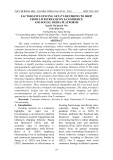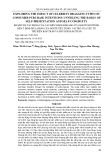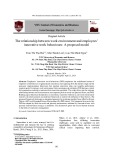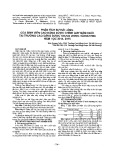
VNU Journal of Economics and Business, Vol. 4, No. 2 (2024) 69-79
69
Original Article
Drivers of sustainable entrepreneurship education:
An analytic hierarchy process
Pham Thi Thanh Hang1, Truong Thi Hue2,*
1VNU School of Interdisciplinary Studies
No. 144 Xuan Thuy Street, Cau Giay District, Hanoi, Vietnam
2VNU International School
No. 144 Xuan Thuy Street, Cau Giay District, Hanoi, Vietnam
Received: January 29, 2024
Revised: April 8, 2024; Accepted: April 25, 2024
Abstract: This research aims to explore the drivers of sustainable entrepreneurship (SE) education
for university lecturers and their hierarchy of prioritization. An Analytic Hierarchy Process (AHP)
method was applied to analyze data collected from nine entrepreneurship-education experts based
in eight universities in Vietnam. The results show that there are several identified key drivers, ranked
based on descending prioritization, namely: encouraging youth, social problems, talent shortage,
and connection with practitioners. Several sub-factors may also be ranked as having relative
importance to SE, with the top five being “encourage students to engage in social enterprises”,
“venture creation is our responsibility”, “students age group drives the educators’ interest”, “students
engage in heated discussions”, and “failure of the established institutions”. This could be the first
endeavor to assess and rank the drivers of SE education, thereby offering some meaningful
contributions to both academia and practice.
Keywords: Entrepreneurship, sustainable entrepreneurship, entrepreneurship education.
1. Introduction *
For many years, entrepreneurship has been
considered one of the many solutions for
employment as well as social and environmental
issues (Muñoz, 2018). Realizing this, some
researchers have recently acknowledged the
relationship between traditional
entrepreneurship, society, and the environment,
and hence have developed a new type of
________
* Corresponding author
E-mail address: tthue@vnu.edu.vn
https://doi.org/10.57110/vnujeb.v2i6.256
Copyright © 2024 The author(s)
Licensing: This article is published under a CC BY-NC
4.0 license.
entrepreneurship called “sustainable
entrepreneurship” (SE) (Cohen & Winn, 2007).
In the last decade, SE has gradually received
more attention, partly because entrepreneurs and
start-ups were the main actors in the rise in
prominence of clean and green production
(Fichter & Tiemann, 2020). SE plays a crucial
role in achieving the United Nations Sustainable
Development Goals (SDGs), such as innovation
and infrastructure, responsible production and
VNU Journal of Economics and Business
Journal homepage: https://jeb.ueb.edu.vn

P.T.T. Hang, T.T. Hue / VNU Journal of Economics and Business, Vol. 4, No. 2 (2024) 69-79
70
consumption, health and well-being, and climate
adaptation; therefore, it requires the involvement
of stakeholders, including educators
(Apostolopoulos et al., 2018).
SE is an area of research that is still in its
nascent stage (Arru, 2020). Some studies have
focused on different subjects within the SE
domain. However, the literature provides very
little insight into the motivations for educators to
teach SE. So far, the majority of the studies are
mainly focused on the impacts of SE intention
(Fichter & Tiemann, 2020; Romero-Colmenares
& Reyes-Rodríguez, 2022; Thelken & de Jong,
2020; Vuorio et al., 2018). On the other hand,
some studies investigated SE’s impacts on
finance, the environment, and society (Criado-
Gomis et al., 2018), the details of SE’s processes
(Johnson & Schaltegger, 2020), principles of
behaviours in SE (Arru, 2020), and drivers of SE
(Thelken & de Jong, 2020). These studies within
the literature have mainly applied quantitative
methods and techniques such as structural
equation modeling (SEM) and regression. It
seems that there have been no works utilizing the
Analytic Hierarchy Process (AHP) method.
Academic institutions and lecturers play a
decisive role in SE training (Dentchev et al.,
2018). They help improve the self-efficacy of
young entrepreneurs (Hockerts, 2015) and
support enterprises and start-ups that are
established for social purposes (Kummitha &
Majumdar, 2015). In some studies, the adoption
of SE may be sped up through various
educational aspects such as fostering factors that
influence the university’s support for SE (Fichter
& Tiemann, 2020), designing a sustainability-
driven entrepreneurship curriculum (Cincera et
al., 2018), and cultivating academic training
(Miller et al., 2012). However, the literature
provides very little knowledge of the factors that
drive lecturers to teach SE (Fichter & Tiemann,
2020). According to Neck & Corbett (2018), SE-
related studies from the perspective of trainers
has been relatively silent. The research on this
subject is extremely important, as pre-SE
training provides the necessary capacity – not
only for sustainable entrepreneurs but also their
employees and society (Starkey et al., 2009).
Moreover, this subject should be given more
attention, especially in developing countries like
Vietnam, as there are urgent calls for studying
SE in the context of emerging environmental
contexts (Romero-Colmenares & Reyes-
Rodríguez, 2022). This importance is further
compounded by the fact that Vietnam’s
entrepreneurship education system is still in its
early stages (Pham et al., 2021).
On the other hand, it has been argued
recently that the higher education systems in
many countries have not contributed to the
greater global sustainability agenda. This is
because most of them have neither thoughtfully
provided learners with the opportunity to acquire
knowledge of and adopt sustainable practices,
nor promoted sustainable lifestyles (Tilbury,
2011). Some advocates of global sustainability
are of the opinion that higher education
institutions have not adequately provided forums
or avenues for comments, discussions, and
actions on the topic of sustainability. This has
prevented students from contributing to the
adoption of sustainable practices in life, work,
and business (Wals & Jickling, 2002). In the
field of management, some researchers have
even pointed out that business schools are
significantly contributing to an unsustainable
and unequal way of life (Fotaki & Prasad, 2015),
due to their preoccupation with the market and
school ranking (Gioia & Corley, 2002).
Therefore, it is imperative for researchers to
raise awareness and motivation among
university lecturers to advocate SE education.
To fill the above research gaps, the authors
have applied the AHP method in this study to
answer the following questions:
Q1: What drivers speed up SE education
adoption among university lecturers?
Q2: What is the relative importance of such
drivers?
The remaining sections of the study are
organized as follows: Section two introduces the
theoretical background. Section three presents
the research methodology. Section four details
the research results. Section five reports the
discussions and implications. Section six
concludes.
2. Literature
2.1. Sustainable entrepreneurship and the role of
education
In general, SE may be defined from two
different perspectives: an entrepreneurship

P.T.T. Hang, T.T. Hue / VNU Journal of Economics and Business, Vol. 4, No. 2 (2024) 69-79
71
process or sustainable management (Terán-
Yépez et al., 2020). Through the
entrepreneurship process approach, Belz &
Binder (2017) define SE as the realization and
utilization of business opportunities to create
future products with economic, environmental,
and social interests. Through the sustainable
management approach, Shepherd & Patzelt
(2011) define SE as “focused on the preservation
of nature, life support, and community in pursuit
of perceived opportunities to create future
products, processes, and services for profit,
where profit is broadly construed to include
economic and non-economic gains to
individuals, the economy, and society“ (page.
142). Similar to this approach, Urbaniec (2018)
considers SE as a new business practice that
brings about new opportunities for the creation
of enterprises that are trying to solve ecological
and social issues.
Many researchers believe that building a
sustainable future is connected closely to the role
of education. This role is currently globally
recognized, as evident from the formation of the
United Nations Decade for Education for
Sustainable Development (UNECE, 2012).
Higher education institutions are deemed as the
main agents in the conversion to a sustainable
society – through their various functions, such as
education, scientific research, and community
service (Haertle et al., 2017). One of the main
objectives of sustainable integration in higher
education is to provide future graduates with
knowledge and skills to face great challenges
faced by the global society and build a
sustainable future (Décamps et al., 2017). Calls
for a sustainable approach to lectures and lessons
in universities have remarkably increased in the
last few years (Kolb et al., 2017). Some training
strategies have been applied in business schools
in response to these calls (Storey et al., 2017),
especially involving the SE teaching strategy.
Universities and lecturers play an important
role in linking entrepreneurial training and
sustainable development, by providing training
to entrepreneurs who contribute to sustainable
development (Kummitha & Kummitha, 2021).
They equip entrepreneurs with behaviour and
skills that allow them to capture business
opportunities, create social demand, initiate
sustainable enterprises, and ensure sustainability
in business affairs (Diepolder et al., 2021). Some
universities in the world have developed
dedicated SE programs, consisting of training
and research (Décamps et al., 2017). In most
cases, lecturers integrate business-related
subjects with entrepreneurial training to build SE
education modules (Gast et al., 2017). Business
universities participate in the provision of SE
education to encourage their students to engage
in sustainable enterprises in order to deal with
worsening social issues (Kummitha &
Kummitha, 2021). SE education helps
passionate people gain the necessary capacities
and skills to found sustainable enterprises
(Warwick et al., 2017), increase confidence and
behaviour towards entrepreneurship (Vuorio et
al., 2018), and build new connections (Chandra,
2017).
2.2. Drivers of sustainable entrepreneurship
education
In recent years, it seems that there is a lack
of studies that investigate the drivers for
universities or lecturers to adopt SE education,
except for a few isolated researches. For
example, Kummitha (2017) finds that the key
drivers promoting SE teaching is the urge to
solve social and environmental issues. Décamps
et al. (2017), on the other hand, discover that
solving social or ecological issues is the key
objective that promotes academic institutions to
engage in SE teaching. Long et al. (2019),
Vuorio et al. (2018), Cincera et al. (2018), and
Miller et al. (2012) discover that cooperation and
facilitation among students in creating ventures
promotes the introduction of SE courses among
universities and lecturers. Through the platform,
members may also engage themselves with
social issues, which would help increase their
sense of compassion (Miller et al., 2012),
altruism (Vuorio et al., 2018), and sympathy
(Cincera et al., 2018), as well as motivate the
initiation of sustainable enterprises (Long et al.,
2019). In addition, Chandra (2016) points out
that another driving factor of SE teaching is the
internal structures built by universities to
facilitate students' interest in SE practices.
Nevertheless, most structures neither directly
found drivers as their research objectives, nor
brought out a general model of drivers for
universities or SE lecturers.
The research by Kummitha & Kummitha
(2021), while intended to explore the drivers of

P.T.T. Hang, T.T. Hue / VNU Journal of Economics and Business, Vol. 4, No. 2 (2024) 69-79
72
SE, was only focused on the context of business
schools. Through interviews with SE program
educators, the researchers found four key drivers
of SE education, namely: the existence of social
problems, talent shortage, encouraging youth to
engage in sustainability, and connection with
practitioners. According to Kummitha &
Kummitha (2021), ‘social problems’ is a
dimension developed from themes such as
growing social problems, addressing social
problems, and institutional support. This
dimension relates to specific issues such as
increasing disparities, institutional failures, a
strong push for personal authority, a visible and
expanding social enterprise sector, and
rethinking the role of educational institutions.
Talent shortage pertains to topics like venture
creation responsibilities, neglect of job creation
needs in the industry, and ignorance of the
shortage among educators. Encouraging youth
involvement in sustainability involves
motivating students to engage in social causes,
teachers being motivated by their students' age
range, and students engaging in lively
discussions on social enterprise. Connecting
with practitioners involves establishing strategic
alliances to provide resources, enabling student
collaboration with practitioners, and fostering
connections that inspire students. However, the
research mainly focuses on three specific types
of training: initiating, ensuring, and integrating.
This work aims to carry out deeper research on a
set of drivers that Kummitha & Kummitha
(2021) and the literature have pointed out, while
also ranking their importance to gain a more
extensive understanding of this subject.
3. Methodology
3.1. Analytic hierarchy process (AHP)
According to Chen (2006), AHP is one of the
most reliable and sound decision-making tools.
Using the AHP method, different items will be
compared on a pairwise basis. After that, the
results from the pairwise comparison will be
further analyzed to rank the relative importance
of each factor and sub-factor. Lee (2014)
believes that results from the AHP method has
valuable implications as inconsistency checking
is required by design. Therefore, AHP is an
appropriate method to answer this study’s
research questions. The minimal AHP sample
size normally varies from 9 to 15 participants,
while it may vary based on the complexity of the
problem being addressed, survey participant
homogeneity, and participant rating accuracy
(Saaty, 1996, 2008).
3.2. Development of hierarchy structure on
drivers of SE education
The hierarchy structure used in this research
comprises three levels (see Table 3). The second
and third levels within the structure include
factors and sub-factors (items) inherited from the
research by Kummitha & Kummitha (2021). The
factors and sub-factors were translated into
Vietnamese and modified to fit the Vietnamese
background. The questionnaire was then sent to
three experts with more than five years of
experience in teaching entrepreneurship. Next,
these three experts were also asked to participate
in a pilot test. The final questionnaire includes
16 items that were grouped into four factors:
social problems, encouraging youth, talent
shortage, and connect with practitioners.
A combined offline and online survey (via
the Google Forms platform) was conducted in
August 2022, in Vietnam. There were nine
experts involved in this study, all of whom are
lecturers with at least five years of expertise and
teaching experience in SE at eight universities in
Vietnam. Eight experts responded online and
one expert provided direct responses. Table 1
displays the characteristics of the experts.
3.3. Prioritization procedure
Table 1. Characteristics of participants
Characteristics
Frequency
%
Gender
Male
6
66.7%
Female
3
33.3%
Academic title
PhD
5
55.6%
MA
4
44.4%
Age
22-30
1
11.1%
31-40
6
66.7%
41-50
2
22.2%
Source: Authors.

P.T.T. Hang, T.T. Hue / VNU Journal of Economics and Business, Vol. 4, No. 2 (2024) 69-79
73
The questionnaire includes two sections. The
first section collects preliminary information
from the experts. The second section asks
experts to compare the relative importance of
four factors and 16 sub-factors, that represent
factors driving the motivation to deliver SE
education.
According to Saaty and Kearns (1985), in the
AHP technique, experts need to compare pairs of
indicators (factors and sub-factors) and then
synthesize them into a matrix of n rows and n
columns (n is the number of indicators). The aij
element represents the importance of the i row
indicators compared to the j column indicators.
𝐴= (𝑎𝑖𝑗)𝑛×𝑛=[1 𝑎12
𝑎21 1… 𝑎1𝑛
… 𝑎2𝑛
⋮ ⋮
𝑎𝑛1 𝑎𝑛2 ⋮ ⋮
… 1]
The relative importance of indicator i
compared to j is calculated by the ratio k (k
ranges from 1 to 9), the opposite of the indicator
j relative to i is 1/k. Therefore aij> 0, a ij = 1/aji,
a ii
=1.
Table 2: The relative importance scale
Accordingly, each expert is required to
compare two factors or items by the hierarchy 1-
3-5-7-9 or the intermediate values 2-4-6-8 (Saaty
& Kearns, 1985). For example, if factors A and
B have the same importance, the respondent is
asked to choose number 1. If A is more important
than B, the respondent is asked to choose from 2
to 9 points (based on the relative importance of
A over B), and vice versa (see Table 2).
3.4. Data synthesis
Microsoft Excel is used to estimate the local
weight, global weight, and consistency ratios
(CR) of the collected data. According to (Saaty,
1990), CR is calculated according to the
following formula:
𝑊
𝑖𝑠
= ∑𝑤
𝑖𝑗
𝑠
∗𝑤
𝑗𝑎𝑚
𝑗=1
i=1,. . . n
w
ijs
: Weight of option i corresponds to the
criterion j
w
ja
: Weight of indicator j
n: Number of options; m:
number of criteria
Then, the relative importance of each factor
and sub-factors (options and indicators) is
integrated. The local weight shows the relative
importance of one item (sub-factors) on its factor
or the importance of one factor on SE education.
The global weight indicates the relative
importance of one item in SE education. All
weights were calculated as per Saaty (1990)’s
suggestion.
4. Results
Table 3 details the relative weights and
ranking of motivational factors of SE education.
The results show that the most important factor
is encouraging youth, followed by social
problems, talent shortage, and connect with the
practitioners, in descending order. The
consistency test reveals that the answers are
generally consistent, with CR = 0.076.
Table 3: Ranking of the drivers of SE education
Factors
Weights
Ranking
Social problems
0.297
2
Talent shortage
0.216
3
Encouraging youth
0.303
1
Connect with the
practitioners
0.184
4
Consistency ratio
0.076
Table 4 shows the relative importance of
items and their respective ranking in the whole
model. The evaluations are consistent, with CR
1/9
1/7
1/5
1/3
1
3
5
7
9
Extremely
unimport-
ant
Very little
important
Quite less
important
Less
important
Equally
important
More
important
Quite more
important
Very
important
Extremely
important


























